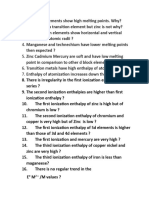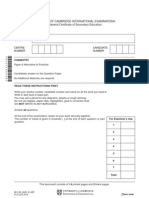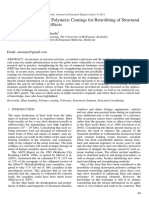0 ratings0% found this document useful (0 votes)
70 viewsD and F Block Questions and Answers
1. Transition elements show variable oxidation states because their (n-1)d and ns electrons have similar energies, allowing them to both participate in bond formation.
2. Many transition elements are colored in aqueous solution due to d-d transitions of unpaired electrons within the d orbitals, which reflect visible light.
3. Transition elements readily form interstitial compounds where smaller atoms like carbon, nitrogen, and hydrogen occupy interstitial sites in the metal crystal lattice.
Uploaded by
Vishan PalCopyright
© © All Rights Reserved
Available Formats
Download as PDF, TXT or read online on Scribd
0 ratings0% found this document useful (0 votes)
70 viewsD and F Block Questions and Answers
1. Transition elements show variable oxidation states because their (n-1)d and ns electrons have similar energies, allowing them to both participate in bond formation.
2. Many transition elements are colored in aqueous solution due to d-d transitions of unpaired electrons within the d orbitals, which reflect visible light.
3. Transition elements readily form interstitial compounds where smaller atoms like carbon, nitrogen, and hydrogen occupy interstitial sites in the metal crystal lattice.
Uploaded by
Vishan PalCopyright
© © All Rights Reserved
Available Formats
Download as PDF, TXT or read online on Scribd
You are on page 1/ 2
d and f block elements -Give reason questions
1. Why do transition elements shows variable oxidation state?
Because the (n-1)d and ns electron are both involving bond formation they are almost equal energies.
2. Most of the transition elements are colour in aqueous solution?
Due to number of unpair electron exit to d-d transition and reflect the light in the visible region (d-d transition)
3. Many of the transition elements are known to form interstial compounds?
smaller atoms like C,N and H occupies intretial site of metal crystal lattice to form interstial complexes.
4. copper is the only element shows positive electorde potential(0.34V)?
It is due to i)higher bond entalpy ii)lower hydration enthalpy.
5. Copper (I) in aqueous solution is unstable?
Cu+1 ---------> Cu(s) +Cu+2 (aq)
6. Transition elements shows paramagnetic in nature?
It is due to number of unpair electron.
7. Cr+2 is reducing agent and Mn+3 is oxidising agent?
Cr+2 is reducing agent because it changed to Cr+3 t2g half filled stable and Mn+3 is oxidising agent because it
changed to Mn+2 is half filled stable.
8.The enthalpies of transition metals are high?
It is due to no of unpair electron and dd overlapping.
9. Which transition element doesnt show variable oxidation state?
Scandium(+3 oxidation state) because it has inert gas configuration.
10. What are transition elements? Write its chracteristics?
Incomplete d-orbital is called transition elements and it has high bond enthalpy and magnetic chracter,and more
tendency to form complexes.
11. What is disproportions reaction ? Give examples?
In a reaction the same element give simultaneously oxidised and reduce products is called disproprotion reaction.
example:Cu +--------> Cu + Cu+2
12. Zinc , Mercury and Cadmium shows low melting point?
It is because they are completely filled d orbital electron.
13. Ionisation of first transition element show irregular ionisation energies why/
It is because due to irregular atomic size of first transition state.
14. Co+2 is unstable in presence of strong ligands why?
Co+2 has one unpair electron in strong ligand field this is unstable so it is oxidised to change Co +3
15. Both oxygen and flourine forms higher oxidation states of transition metals but oxygen can more ablity to form
readily than fluorine?why/
Both oxygen and flourine can form readily higher oxidation state with transition element because both are has
more electronegative and oxygen has variable oxidation state and can form pi bond complex and fluorine cannot.
16. Transition elements act as good catalyst?
i)larger surface area ii)Variable oxidation state iii) Number of unpair electron
17. Transition elements readily form complexes?
I)vaccant d orbital ii)Variable oxidation state iii) Number of unpair electron iv) small size high positive charge
18. The highest oxidation state of a transition metal exists only intheir oxide state.?
Because oxygen has more electronegative and can form pi bond complexes.
19. Which transition metal exhibit +1 oxidation state?
Coppper
20. Density of transition element increases from Titanium to Copper?
Because the atomic radii decreases from Ti to Copper.
21. Manganese shows highest oxidation state of first transition state?
Because manganese has larger number of unpair electron.
22.Why metal -metal bonding more favour of 4d and 5d than 3d?
Because less energy more number of electron in 4d and 5d.
23. There is greater tendency horizontal similarity in the properties of the transitions elements to that of the main
group elements?
Because of simliar atomic radius not much diffference in their size difference.
24. Greatest number of oxidation number of oxidation states in the middle of the series?
because number of unpair electron increases from starting to upto the middle.
25. Sc is a transition element but zinc is not a transition element why?
Sc is incomplete filled transition element but zinc is completely filled transition elements.
26. Compare the stablity of +2 oxidation state of first transition element?
From scandium to copper the stablity of oxidation state of +2 decreases because sum of the first and second
ionisationenergy is increases and except Mn+2,Zn+2 are more stable due to half filled and completely filled .
27. The lowest oxidation of transition element shows basic and higher is acidic or ampoteric why?
lowest oxidation state act as lewis base and higher oxidation state act as lewis acidic in nature.
28. Which element can shows oxidation number and group number same?
Manganese oxidation number +7 and group number also seven.
29.Scandium doesnot have variable oxidation state but it is a transition element?
Scandium ground state electronic configuration has incomplete filled d orbital configuration.
30. Silver is completely filled d orbital configuration but it is transition element why?
silver oxidation state exist incompletely fillde d orbital electronic configuration 4d 9 - Ag+2
31. Zr and Hf have almost identical radii.Give reason?
Due to lanthanoid contraction there is no much atomic radius between 4d and 5d.
32.Actinoids shows variable oxidation states than lanthanoids?
Actinoids has comparable energies of 5f,6d,7s orbitals
33.Actinoids are more reactive than lanthanoids why?
Actinoids has variable oxidation state than lanthanoids.
34.What is misch metal alloy?
Lanthanoids 95% and iron 5% and traces of C,S,Al :uses:Bullet proof material and light flint.
35. What is the lanthanoid contraction? Writ its consequences?
The imperfect sheilding of 4f orbital is called as lanthanoid contraction due to this lanthanoids elements are similar
atomic radii. Consequences:1.Due to identical of atomic radii it is difficult to separate lanthanoids elements.
2.4d and 5d has similar atomic radii. 3. Ln(OH)3 basicity decreases along the period.
36. Difference between lanthanoid and actinoids?
Ln:It has less tendency towards form complex,Do not form oxocations
An:It has greatern tendency to form complex,it form oxocations(UO2+2,)
37 similarity between lanthanoids and actinoids?
Both have +3 oxidation state more stable,Both shows magnetic and spectral properties.
38. Ce+4 is good oxidising agent?
because Ce+3 is common oxidation state is more stable.
39. Eu+2 is good reducing agent?
Because Eu+3 is common oxidation state is more stable.
40. Why La3+ and Lu+3 have colourless?
La+3 4f0 and Lu+3 4f14 inert gas and completely filled electronic configuration.
Why Actinoid contraction is greater than Lanthanoid contraction?
The 5f imperfect sheilding is greater than 4f.
PREPARED BY:P.GOPU M.SC MPHIL.B.ED
gopuchem2001@rediffmail.com
9283184234
http://www.chemistryhometuitionchennai.in
You might also like
- Questions 3rd Geologya and Ch. Applied 2023 PDFNo ratings yetQuestions 3rd Geologya and Ch. Applied 2023 PDF20 pages
- Training On Dry Fog Dust Suppression SystemNo ratings yetTraining On Dry Fog Dust Suppression System10 pages
- Chemistry Imp the Dandf Block Elements Mix (1)No ratings yetChemistry Imp the Dandf Block Elements Mix (1)14 pages
- 21 - 59 - 21 - 11 - 12 - 2023 - Chapter 8 - D and F Block Ncert Exercise QuestionsNo ratings yet21 - 59 - 21 - 11 - 12 - 2023 - Chapter 8 - D and F Block Ncert Exercise Questions15 pages
- Chapter 4 – Important Questions and AnswersNo ratings yetChapter 4 – Important Questions and Answers3 pages
- d and f block-Important board questions with answersNo ratings yetd and f block-Important board questions with answers6 pages
- Important question of d and f block elementsNo ratings yetImportant question of d and f block elements8 pages
- IMPORTANT QUESTIONS FROM PREVIOUS PAPERS DfgdhfgnhfjghjghdhtyNo ratings yetIMPORTANT QUESTIONS FROM PREVIOUS PAPERS Dfgdhfgnhfjghjghdhty27 pages
- Important Questions For CBSE Class 12 Chemistry From CBSETUTSNo ratings yetImportant Questions For CBSE Class 12 Chemistry From CBSETUTS25 pages
- NCERT - Solutions - For - Class - 12 - Chemistry - Chapter - 8 - The - D - and - F - Block - ElementsNo ratings yetNCERT - Solutions - For - Class - 12 - Chemistry - Chapter - 8 - The - D - and - F - Block - Elements10 pages
- Cbse Q -CHAPTER 8- d and f- block elements -No ratings yetCbse Q -CHAPTER 8- d and f- block elements -5 pages
- Chemistry The D and F Block Elements Q&A 5marksNo ratings yetChemistry The D and F Block Elements Q&A 5marks14 pages
- 002 - Repair - Trough Thickness-PQR - Rev.1No ratings yet002 - Repair - Trough Thickness-PQR - Rev.12 pages
- Greenstar 25Si/30Si: User Instructions & Customer Care GuideNo ratings yetGreenstar 25Si/30Si: User Instructions & Customer Care Guide20 pages
- Effect of Polypropylene Fibres On Strength and Durability Performance of M-Sand Self Compacting ConcreteNo ratings yetEffect of Polypropylene Fibres On Strength and Durability Performance of M-Sand Self Compacting Concrete22 pages
- The Periodic Table of The Elements (Including Atomic Radius)No ratings yetThe Periodic Table of The Elements (Including Atomic Radius)1 page
- Lecture 4: Biological Molecules: 1 BIOL 211 Spring 2012No ratings yetLecture 4: Biological Molecules: 1 BIOL 211 Spring 201267 pages
- University of Cambridge International Examinations International General Certifi Cate of Secondary EducationNo ratings yetUniversity of Cambridge International Examinations International General Certifi Cate of Secondary Education16 pages
- 26071-203-V66A-MTFR-20013 - Rev002 - NDE Procedure (PAUT, RT, PT, MT, UT)No ratings yet26071-203-V66A-MTFR-20013 - Rev002 - NDE Procedure (PAUT, RT, PT, MT, UT)189 pages
- Introduction Tomarine Chemistry. J. P. Riley and R. Chester. Academic Press, LondonNo ratings yetIntroduction Tomarine Chemistry. J. P. Riley and R. Chester. Academic Press, London2 pages

























































































